U.S. Says Chinese Fighter Jet Flew Dangerously Close to American Plane

The U.S. military said on Thursday that a Chinese fighter jet flew dangerously close to a U.S. Air Force aircraft that was conducting routine operations over the South China Sea on Dec. 21, nearly causing the planes to collide.
The Chinese pilot of a J-11 jet “performed an unsafe maneuver,” flying in front and within 20 feet of the nose of a U.S. Air Force RC-135 plane, the U.S. military said in a statement, adding that the American pilot was forced to take “evasive maneuvers to avoid a collision.”
The U.S. Indo-Pacific Command, which is part of the United States Armed Forces and is responsible for protecting the national interests of roughly three dozen countries in the region, said in a statement on Thursday that it expected all states in the region “to use international airspace safely and in accordance with international law.”
A spokesperson for the command, referring to China’s People’s Liberation Army by its initials, also said in an email: “We have seen an alarming increase in the number of unsafe aerial intercepts and confrontations at sea by P.L.A. aircraft and vessels.
“So this latest incident reflects a concerning trend of unsafe and dangerous intercept practices by the P.L.A. that are of grave concern to the United States.”
More on U.S. Armed Forces
- Defense Bill: Congress passed a $858 billion defense bill that would rescind the coronavirus vaccine mandate for troops and increase the defense budget $45 billion over President Biden’s request.
- A Boost for the N.R.A.: Instructors in military-sponsored J.R.O.T.C. classes have offered to promote the gun rights organization in high schools in exchange for money for their marksmanship programs.
- Abortion: The Pentagon is seeking to reassure service members worried about having access to abortions in states where the procedure is banned with travel funds and other support.
- Navy SEAL Recruitment: The high failure rate of the elite force’s selection course shunts hundreds of candidates into low-skilled jobs.
As to why the American military waited eight days to publicize the encounter, another spokesperson wrote, “Disclosure of this type takes time to verify details, obtain and declassify imagery and make proper notifications to other government agencies.”
A day after the encounter, the U.S. Indo-Pacific Command said in a statement that it was “closely tracking” Chinese military activities in the South China Sea, the Philippine Sea and the East China Sea. And it emphasized that it continued to “oppose any military pressure or coercion against our allies and partners in the region.”
China has long laid claim to the islands in the disputed South China Sea. In a 2015 speech in Singapore, China’s top leader, Xi Jinping, said that the islands had been under Chinese control “since ancient times” and that China “must take responsibility to safeguard its territorial sovereignty and legitimate maritime interests.”
Beijing has become more assertive in recent years, building military infrastructure in the sea and sending ships and aircraft near islands claimed by both Japan and China. Earlier this year, Secretary of State Antony J. Blinken called China the biggest challenger to the international order and said the United States would work with allies to curb its aggressive actions.
Australia and Canada, both American allies, have recently accused the Chinese military of unsafe intercepts over Pacific waters. In June, Chinese jets repeatedly buzzed a Canadian plane monitoring North Korea, coming so close sometimes that the pilots could see each other. In May, the Australian government said that a Chinese plane had fired flares, cut in front of an Australian plane and ejected chaff, which contains metal used to throw off missiles.
In response, Senior Col. Tan Kefei, a spokesman for the Chinese Defense Ministry, said in a statement that Australia had “seriously threatened China’s sovereignty and security.”
“It is the Australia side that confuses black and white, repeatedly disseminates false information and instigates the hostility and confrontation,” Colonel Kefei added.
Taiwan, a self-governing island long claimed by Beijing, also said that China sent an unprecedented number of military aircraft — at least 71 fighter jets, maritime patrol planes and drones — near its territory this month, days after President Biden expanded support for Taiwan.
The episodes have led to fatal collisions. In 2001, a Chinese fighter jet collided with a U.S. Navy surveillance plane over the South China Sea, killing the Chinese pilot and forcing the American plane to make an emergency landing on Hainan Island.
The Chinese government held the 24 members of the American crew for more than a week, releasing them only after an apology letter was sent by the American ambassador to China.




